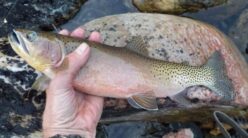That’s a trick question because they are typically considered the same species (Rangifer tarandus), though there are seven subspecies worldwide.
That being said, did you ever take Santa for a rancher? Elf, world traveler and CEO of his North Pole workshop and distribution center, yes.
But I forget sometimes that he also has to manage his herd of reindeer, and that must take some doing. Obviously, he must maintain at least a small number of animals to facilitate his global operations. He has his standard favorites that pull his sleigh each year (he actually names them), but in the event of an injury or other malady and considering their typical 15-year lifespan in captivity, he must be prepared with backup.
I can’t even begin to guess how many reindeer Santa has reared over the years or how much he has spent on feed, vaccinations, vet bills and other items relevant to caring for domesticated livestock — especially when you consider the special talents these particular reindeer possess.
Whether Santa’s reindeer are uniquely adapted or under the influence of magic, they can fly. This has got to make corralling reindeer very difficult. Perhaps, he employs an open range concept and keeps them baited to his land with feed. No one knows. What I do know is that bats are apparently not the only mammals that fly, though they are way too small to pull a sleigh and they hibernate during the winter anyway.
The exact locations of Santa’s Workshop, the Claus Family cabin and flying reindeer at the North Pole are top secret and rightfully so. However, reindeer as a species are easy enough to find in the tundra regions of Europe and Asia.
The caribou, which is thought to be essentially the same species (just bigger), live primarily above the tree-line in arctic North America and Greenland. A small number of caribou can even be found in the very northern portion of Idaho’s panhandle, and they are abundant in Alaska.
Now, this next paragraph is a mind blower. Both sexes of reindeer/caribou grow antlers, the only member of the deer family to do so. In comparison to body size, they have the largest and heaviest antlers of all living deer species. Antlers start to grow in early spring and are lost by the bulls shortly after the rut. Females keep their antlers through the winter and lose them about the time the calves are born in the spring.
That makes me wonder if artist renderings of Santa’s reindeer are correct. Either all of Santa’s reindeer are female because they are always drawn with antlers (and only the females have antlers in the winter months). Or it is not accurate to always draw reindeer with antlers. Christmas card companies may want to take note of that biological fact.
The double-layered coat of the reindeer/caribou provides excellent insulation against cold temperatures. The undercoat is a fine, soft wool. The top layer is composed of hollow, sharply tapered hairs, which help trap heat close to the body and increases buoyancy for swimming across a river or other water body. Remember, not all have flight capabilities.
They have broad hooves with two toes that spread to help walking on soft ground or for digging in snow. Spongy footpads provide traction in marshy fields or boggy summer tundras. The pads shrink and harden in winter and are covered with tufts of hair to reduce slipping on icy ground … and snowy rooftops.
Reindeer/caribou make a clicking noise when walking. This is produced from a tendon rubbing across a bone in the foot. It is believed that this helps keep the herd together in blizzard conditions. It is also believed that one reindeer has a brightly lit nose for guiding a herd in blizzard conditions. However, that has never been scientifically verified.
The keen nose of the reindeer/caribou allows them to find food buried deep in the snow (or scattered on rooftops). They eat grasses, sedges, flowering plants, horsetails, willow leaves and lichens in the wild.
Santa undoubtedly provides alfalfa hay and herbivore pellet mixes to his herd, as is done in North American zoos. Santa’s particular livestock likely has special microbes in their digestive tracts that can break down the overabundance of simple sugars found in cookies, and they must have “bionic” livers for butter digestion. I am only guessing here. But it seems logical.
Reindeer/caribou can run at almost 50 mph, but only for short distances. Of course, flying reindeer must achieve astronomical speeds if they are able to circumnavigate the globe in one night. No one has clocked a flying reindeer, unless that information is maintained in secret UFO files somewhere.
Females (cows) reach sexual maturity between 16 and 28 months and typically give birth to single calves, usually weighing about 13 pounds. The calf is unspotted and resembles the adult. Newborns can walk within 90 minutes and in a day can outrun a person.
Did Santa invent the idea of domesticating reindeer? No! Reindeer were domesticated at least 3,000 years ago in Europe and Asia. It is even thought that hunters once used tame reindeer on leashes to help them sneak closer to wild herds. Just try that with an elk! Actually, don’t. That would be against the law … and dangerous.
Eventually, reindeer were herded for food and used to pull sleds. Even today, native peoples across Scandinavia, Siberia, Mongolia and Northern China use reindeer herding as the basis for their livelihoods.
The worldwide reindeer/caribou population, including domesticated reindeer, is about 5 million, including approximately 750,000 caribou in Alaska. Amazing that the gift of flight is limited to so few animals at the North Pole, but I for one am grateful for that little bit of magical evolution which adds to a child’s wonder this time of year.
Jennifer Jackson is the regional conservation educator for the Idaho Department of Fish and Game, southeast region.



